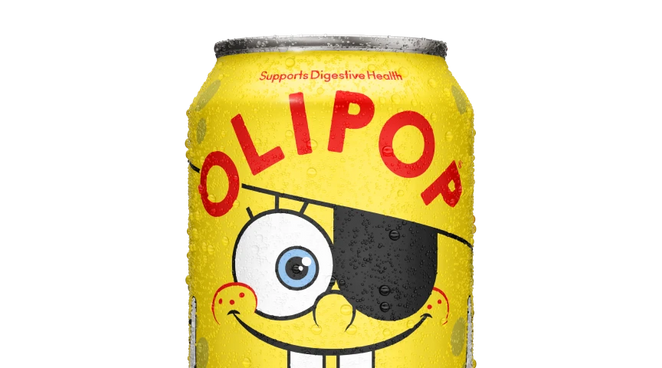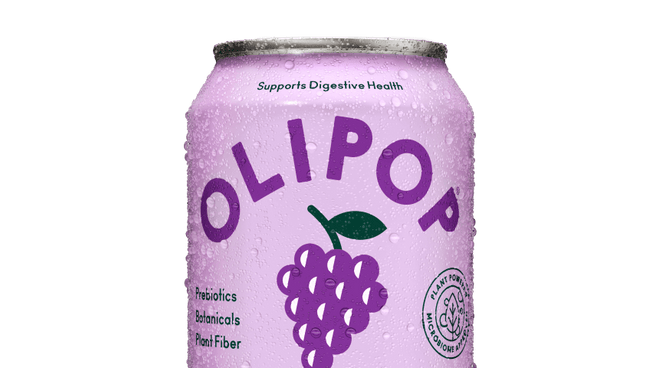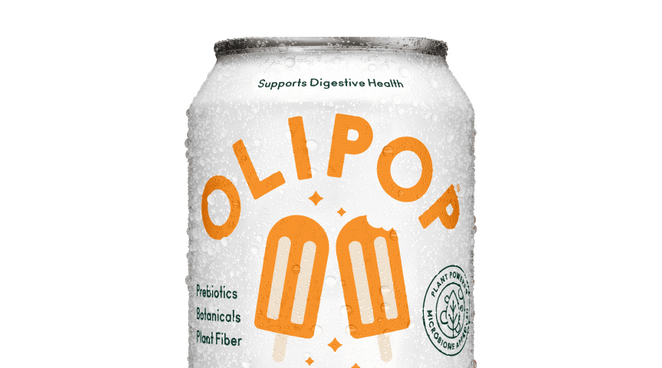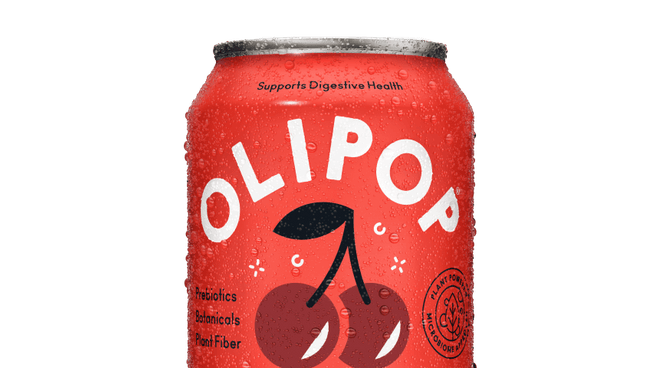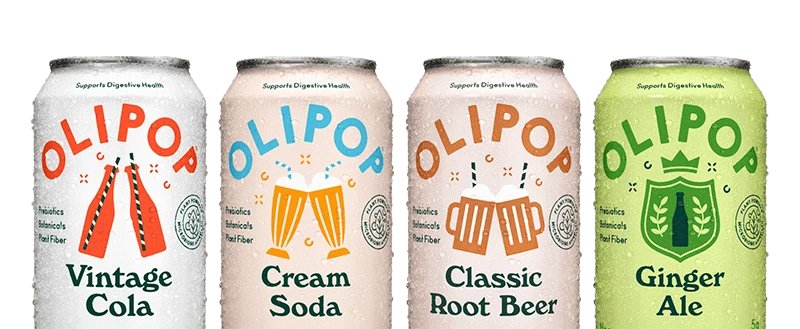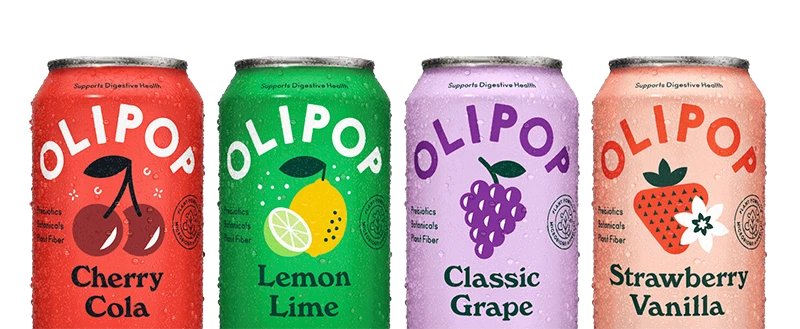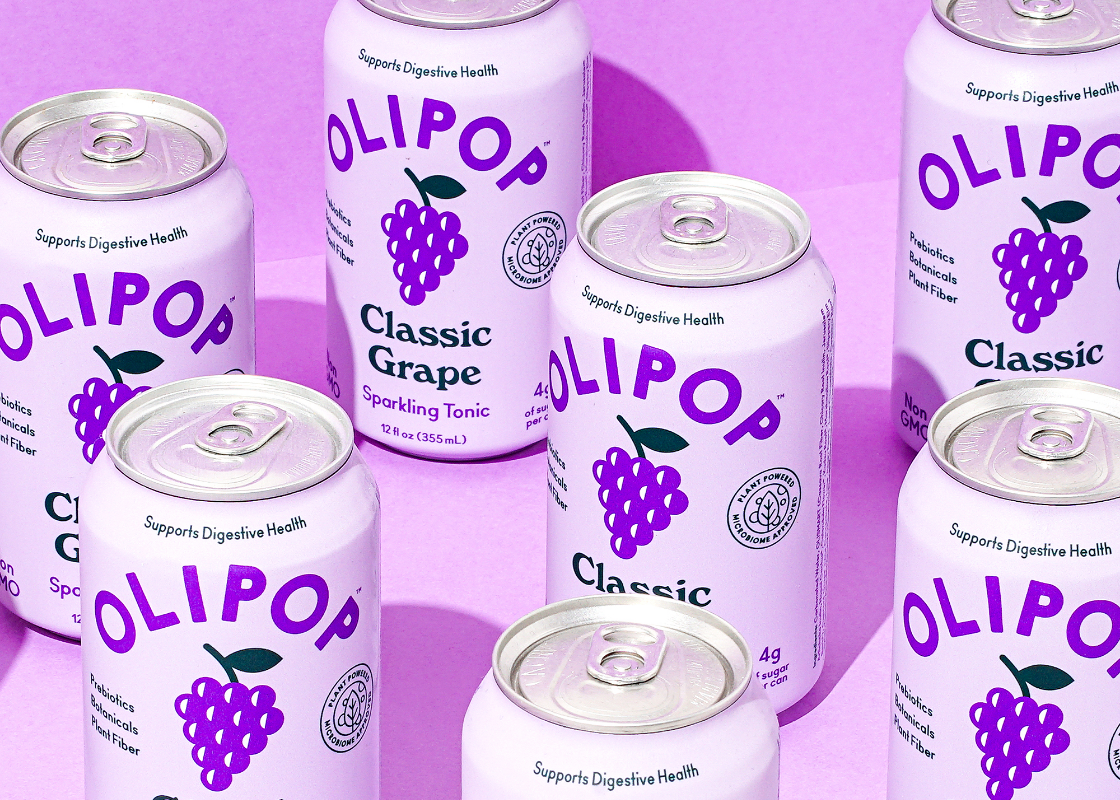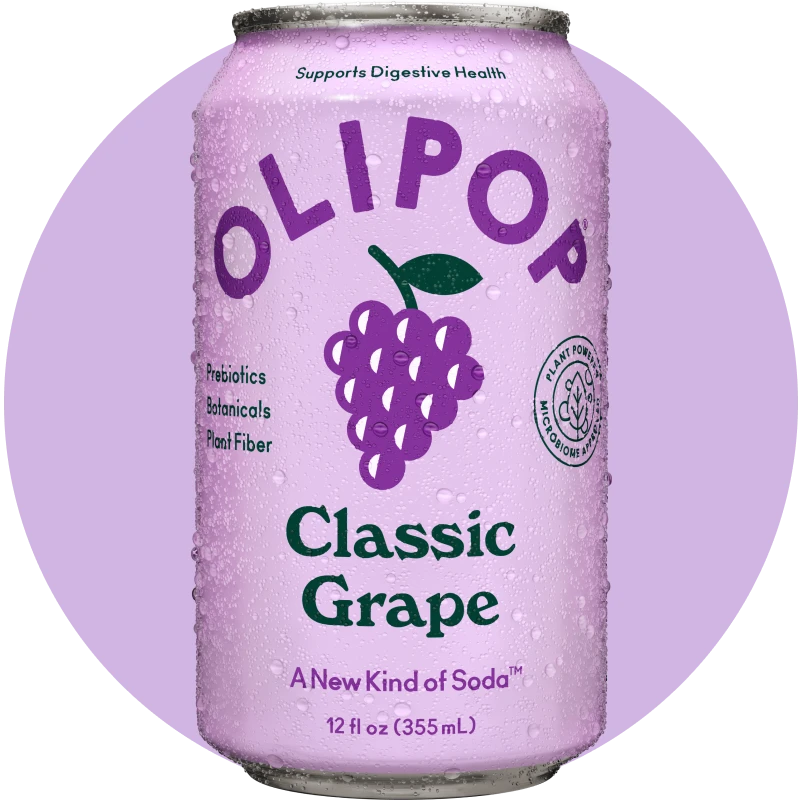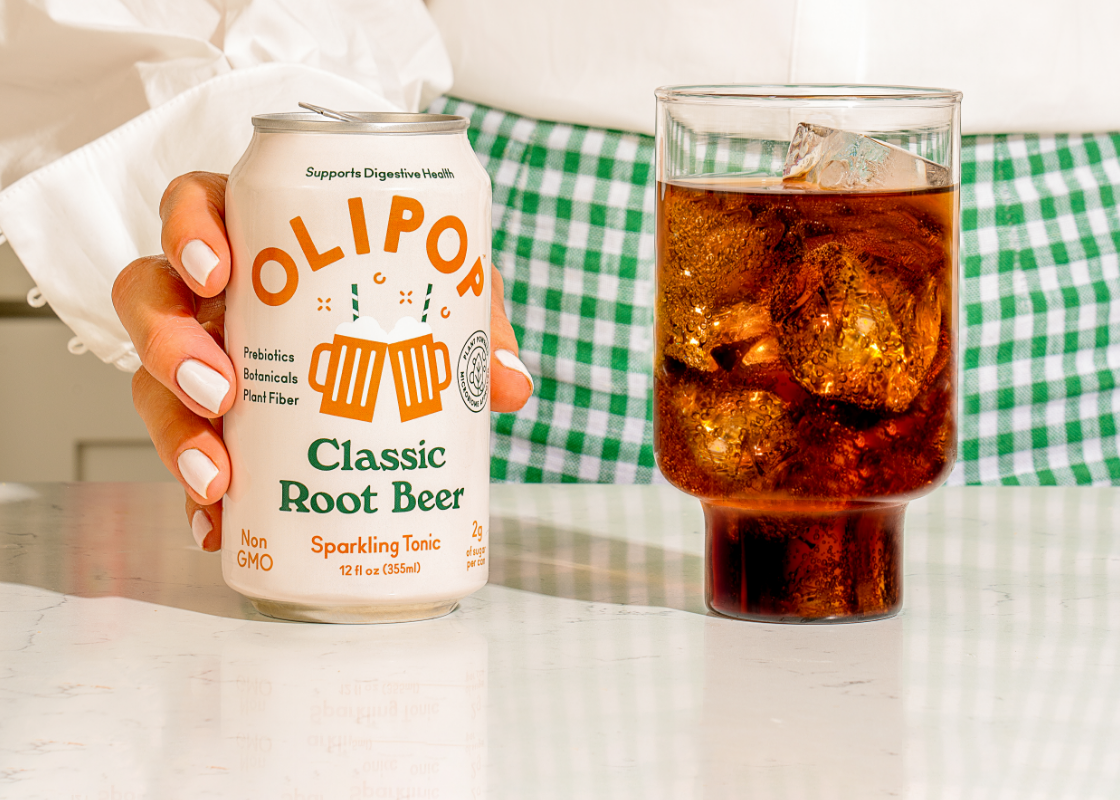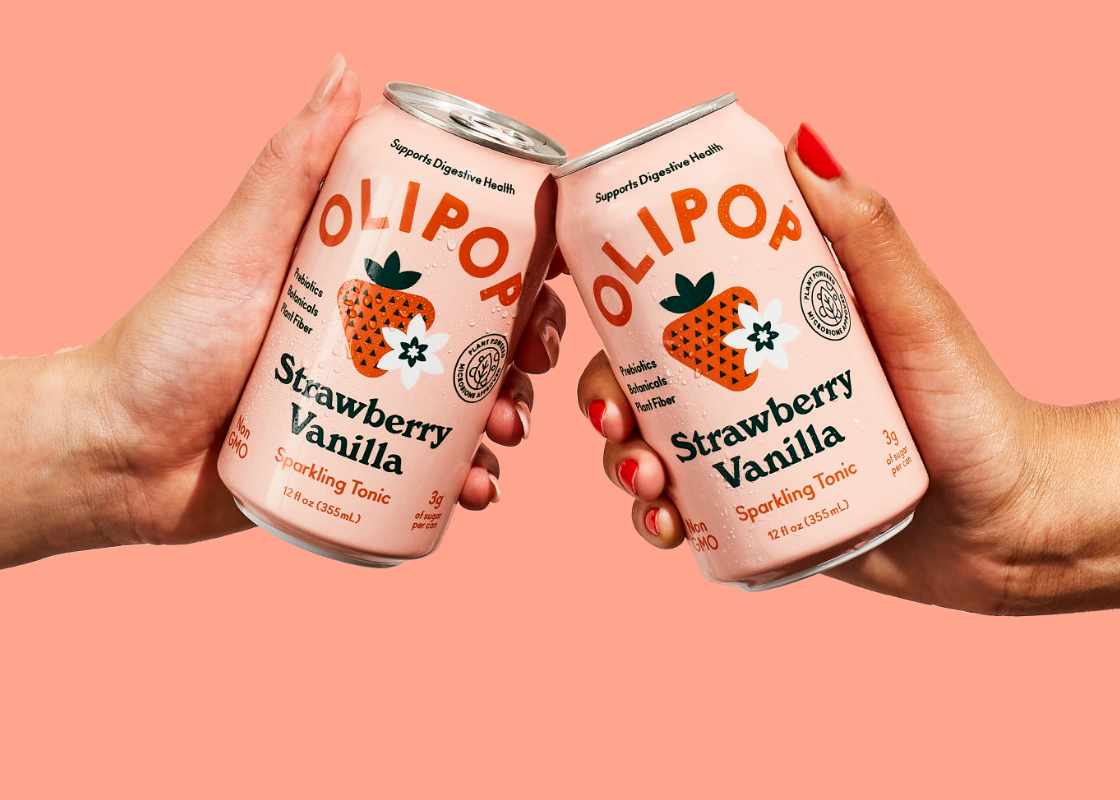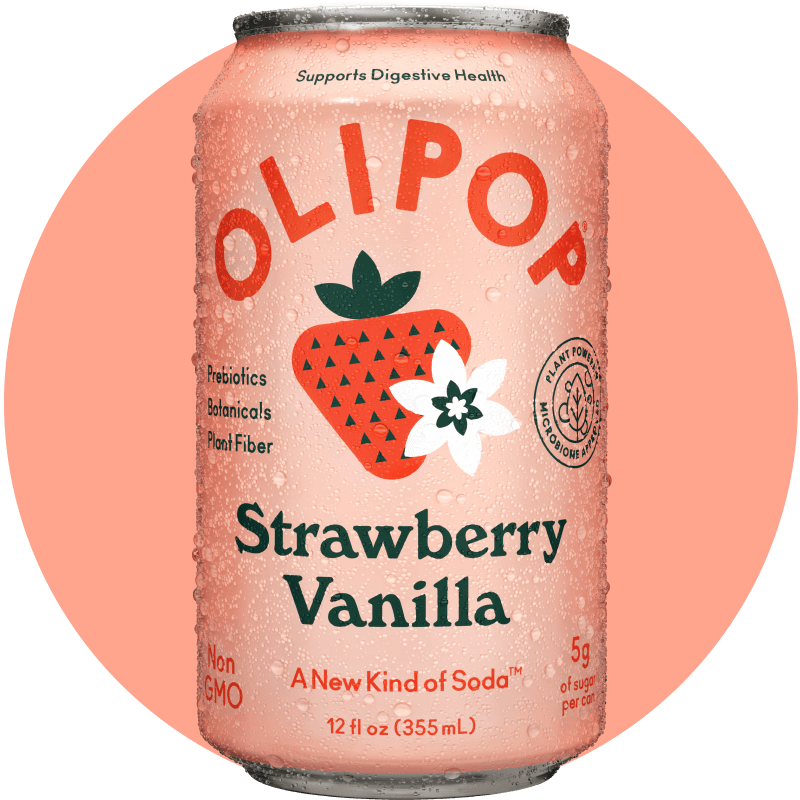What Is OLIPOP?
OLIPOP is a deliciously refreshing soda crafted with plant fiber and prebiotics to support your digestive health. Every can is considered high in fiber and has 2-5g of sugar. OLIPOP comes in delicious “soda-style flavors” for that nostalgic refreshment with function.
Why Is It Called OLIPOP?
Our name represents the Yin and Yang of the OLIPOP brand identity: a cutting-edge solution for digestive health that leverages the latest in scientific research around the human microbiome and a commitment to making a fun and delicious soda that you’ll always want to stock in your fridge.
The story goes that our co-founders, Ben and David, were sitting around a table throwing around ideas for what their epic new prebiotic soda should be called. How could they come up with a fun way to convey to people that they were drinking a delicious, familiar beverage with a scientific twist? That's when David had an idea. Ben was always geeking out about oligosaccharides, a type of microbiome-supporting prebiotic we use in OLIPOP, so David thought, “why not use that?” So they did.
As David would so eloquently put it, OLIPOP comes from combining the words oligosaccharide and the word pop—aka soda pop. (By the way, if you’ve ever been curious about why soda is also called pop, it’s because back in 1812 when the term was coined, soda was bottled with corks, and the cork would “pop” when it was drawn!)1
But Why Is OLIPOP Named After Oligosaccharides?
So, hold up — you mean to tell us that you named your soda after fiber? Yes, yes we did. And the reason is simple: we want to make it as easy as possible for you to support your digestive and microbiome health, which is why we snuck prebiotics into the most delicious soda you can buy.
OLIPOP is the result of years working alongside leading human gut microbiome researchers to find ingredients that can fuel our microbiomes and support digestive health.
During this process, we learned more about oligosaccharides and the benefits they can have on our health. We think their benefits are so stellar that we knew we had to make them a core part of our brand—hence why they’re in our name!
What Exactly Are Oligosaccharides?
Alright nerds, put on your glasses! To understand what oligosaccharides are, we can break down the word into “oligo” and “saccharide.” “Oligo” means “few,” and “saccharide” is one sugar molecule, so oligosaccharide translates to few sugar molecules—and that’s basically what they are!
Oligosaccharides are carbohydrates made up of chains of 2 to 10 sugar units. They are found in plants, fermented drinks like beer, honey, dairy foods, and human breast milk.2 In plants, oligosaccharides have many functions, including playing a role in cell signaling, supporting a plant’s immune response, and acting as energy storage.3
There are many different families of oligosaccharides, which differ based on the length and types of sugar molecules in the chain, including:4
- Fructo-oligosaccharides (FOS), also known as oligofructose or fructans
- Galacto-oligosaccharides (GOS)
- Isomalto-oligosaccharides (IMO)
- Raffinose family of oligosaccharides (RFO)
- Malto-oligosaccharides (MOS)
Why Are Oligosaccharides Important To Our Health?
Here’s where it gets relevant for you: when we eat plants—well, any food—our bodies get to digesting all the nutrients—proteins, fats, carbs, and all—into smaller units that we can use for energy, cellular functions, building muscle, and more.
But the thing is, we can’t digest most oligosaccharides (malto-oligosaccharides are the exception). That’s because humans do not produce the specific enzymes necessary to break down the unique bonds between the sugars in oligosaccharides, so these carbs move through the intestinal tract completely unabsorbed. This is actually a good thing, because our beneficial gut bacteria use these carbs as food, and we call these bacteria-feeding oligosaccharides “prebiotics.” By definition, prebiotics are substrates (in this case, oligosaccharides) that are selectively utilized by host microorganisms (the probiotic bacteria in your gut), conferring a health benefit (the metabolites the bacteria produce after fermentation that support human health).5
Rather than being digested by human gut enzymes, prebiotic oligosaccharides pass through the gut until they reach your large intestine, where your gut microbiome is located. The living beneficial bacteria that call your gut home do produce the enzymes that break down these carbohydrates, which they then ferment and metabolize into beneficial compounds, like short chain fatty acids (SCFA), that support your gut health.
A growing body of research has identified many health benefits of prebiotic oligosaccharides, including enhancing beneficial bacteria such as Bifidobacterium and Lactobacillus species and supporting mineral absorption.
The health benefits of oligosaccharides are more important now than ever before. This is why we made OLIPOP, a better-for-you soda. We cut out up to 98% of the sugar of your traditional non-diet soda and instead made it a high-fiber drink.
Where Can You Find Oligosaccharides?
You may not have been familiar with the name before today, but you’ve been eating oligosaccharides your whole life! On average, Americans consume 1 to 4 grams of oligosaccharides per day.6
Varying percentages of oligosaccharides can be found in over 36,000 plants—as well as algae, bacteria, yeast, and fungi—but certain foods are better sources than others:7 8 9 10
Fructo-oligosaccharides
- Chicory root
- Legumes
- Asparagus
- Artichoke
- Barley
- Tomato
- Onion
- Banana
- Rye
- Garlic
Galacto-oligosaccharides
- Green peas
- Beans (brown, kidney, red, white)
- Lentils
- Chickpeas
Raffinose family of oligosaccharides
- Soybeans
- Pea seeds
Isomalto-oligosaccharides
- Honey
- Fermented foods
What Prebiotics Are In OLIPOP?
We know your gut health is closely linked to your overall health, which is why we add prebiotic oligosaccharides to every can of OLIPOP in a blend that we call OLISMART. OLISMART is our proprietary blend of several unique plant fibers and prebiotics, each hand-picked for their distinct biome-supporting benefits. OLISMART features several sources of oligosaccharide prebiotics which may include: Jerusalem artichoke inulin, chicory root inulin, and cassava root fiber.
Jerusalem Artichoke Inulin
Inulin is a type of fructo-oligosaccharides (FOS) that is on the longer side; most short-chain FOS are between 2 to 7 units long, while inulin can be between 2 and 60 units. And with longer chains comes more prebiotic activity. One in-vitro study found that inulin has a slower fermentation rate and higher prebiotic potency than oligofructose, meaning it can more effectively support the growth and health of beneficial gut bacteria species.11
Jerusalem artichoke is a species of sunflower native to North America that is harvested for its root tuber. Also called a sunchoke, Jerusalem artichokes have no relation to the globe artichoke you’re familiar with in grocery stores.
Jerusalem artichoke root is a highly concentrated source of prebiotic inulin and FOS, which make up 9-12% of its dry weight. This may give it prebiotic effects.12
Chicory Root Inulin
Chicory is a flowering plant in the dandelion family, and its roots are a source of the prebiotic inulin. Chicory root is often used as a coffee substitute, and chicory leaves are commonly used in salads. Chicory root inulin may support healthy bowel movements and have a prebiotic effect by supporting the growth of beneficial bacteria in the microbiome.13 14
Cassava Root Fiber
Cassava is one of the world’s cheapest and most popular staple crops, and is primarily cultivated in countries in subtropical regions in Africa and Asia. This tuber vegetable—similar to a potato—is so popular because it is drought tolerant, so it’s easy to grow, and it’s a good source of energy-dense carbohydrates.15
While cassava root is most frequently eaten cooked (boiled or roasted) or ground into flour, a more recent use for it is as a prebiotic fiber extract. Cassava root fiber is naturally high in prebiotic fructo-oligosaccharides, like 1-kestose. 16
OLIPOP: A Better-For-You Soda
The soda you’ve grown up with may taste good, but it’s nowhere near good for you. Whether it’s the can that contains over 40 grams of added sugar or the bottle sweetened with artificial sweeteners, both diet and regular soda have been linked to numerous health issues, including weight gain, type 2 diabetes, and cardiovascular disease.
But we know it’s not always easy to completely give up something you know and love, which is why we wanted to make a soda that tastes delicious but also offers 6-9g of fiber and 2-5g of sugar to support your microbiome and digestive health.
Plus, with all the nostalgic flavors, it’s always a good time to pick up a can.
Sources
- Von Schneidemesser, Luanne. “Soda or Pop?” Journal of English Linguistics, vol. 24, no. 4, 1996, pp. 270–287., https://doi.org/10.1177/007542429602400403.
- Hanau, Stefania, et al. “Schematic Overview of Oligosaccharides, with Survey on Their Major Physiological Effects and a Focus on Milk Ones.” Carbohydrate Polymer Technologies and Applications, vol. 1, 2020, p. 100013. Crossref, https://doi.org/10.1016/j.carpta.2020.100013.
- Sengupta, Sonali, et al. “Significance of Galactinol and Raffinose Family Oligosaccharide Synthesis in Plants.” Frontiers in Plant Science, vol. 6, 2015. Crossref, https://doi.org/10.3389/fpls.2015.00656.
- O. Ibrahim, Osama. “Functional Oligosaccharide: Chemicals Structure, Manufacturing, Health Benefits, Applications and Regulations.” Journal of Food Chemistry & Nanotechnology, vol. 04, no. 04, 2018. Crossref, https://doi.org/10.17756/jfcn.2018-060.
- Gibson, Glenn R., et al. “Expert Consensus Document: The International Scientific Association for Probiotics and Prebiotics (ISAPP) Consensus Statement on the Definition and Scope of Prebiotics.” Nature Reviews Gastroenterology & Hepatology, vol. 14, no. 8, 2017, pp. 491–502. Crossref, https://doi.org/10.1038/nrgastro.2017.75.
- Loo, Jan van, et al. “On the Presence of Inulin and Oligofructose as Natural Ingredients in the Western Diet.” Critical Reviews in Food Science and Nutrition, vol. 35, no. 6, 1995, pp. 525–52. Crossref, https://doi.org/10.1080/10408399509527714.
- Niness, Kathy R. “Inulin and Oligofructose: What Are They?” The Journal of Nutrition, vol. 129, no. 7, 1999, pp. 1402S-1406S. Crossref, https://doi.org/10.1093/jn/129.7.1402s.
- Guio, Felipe, et al. “Recent Trends in Fructooligosaccharides Production.” Recent Patents on Food, Nutrition & Agriculturee, vol. 1, no. 3, 2009, pp. 221–30. Crossref, https://doi.org/10.2174/2212798410901030221.
- Sabater-Molina, M., et al. “Dietary Fructooligosaccharides and Potential Benefits on Health.” Journal of Physiology and Biochemistry, vol. 65, no. 3, 2009, pp. 315–28. Crossref, https://doi.org/10.1007/bf03180584.
- Liljebo, Therese, et al. “Presence of Fermentable Oligo-, Di-, Monosaccharides, and Polyols (FODMAPs) in Commonly Eaten Foods: Extension of a Database to Indicate Dietary FODMAP Content and Calculation of Intake in the General Population from Food Diary Data.” BMC Nutrition, vol. 6, no. 1, 2020. Crossref, https://doi.org/10.1186/s40795-020-00374-3.
- Wiele, T. van de, et al. “Inulin-Type Fructans of Longer Degree of Polymerization Exert More Pronounced in Vitro Prebiotic Effects.” Journal of Applied Microbiology, vol. 102, no. 2, 2007. Crossref, https://doi.org/10.1111/j.1365-2672.2006.03084.x.
- Nabeshima, Elizabeth H., et al. “Tubers and Roots as a Source of Prebiotic Fibers.” Advances in Food and Nutrition Research, 2020, pp. 267–93. Crossref, https://doi.org/10.1016/bs.afnr.2020.06.005.
- Nishimura, Mie, et al. “Effects of the Extract from Roasted Chicory (Cichorium Intybus L.) Root Containing Inulin-Type Fructans on Blood Glucose, Lipid Metabolism, and Fecal Properties.” Journal of Traditional and Complementary Medicine, vol. 5, no. 3, 2015, pp. 161–67. Crossref, https://doi.org/10.1016/j.jtcme.2014.11.016.
- Menne, Evelyne, et al. “Fn-Type Chicory Inulin Hydrolysate Has a Prebiotic Effect in Humans.” The Journal of Nutrition, vol. 130, no. 5, 2000, pp. 1197–99. Crossref, https://doi.org/10.1093/jn/130.5.1197.
- Nabeshima, Elizabeth H., et al. “Tubers and Roots as a Source of Prebiotic Fibers.” Advances in Food and Nutrition Research, 2020, pp. 267–93. Crossref, https://doi.org/10.1016/bs.afnr.2020.06.005.
- Sancho, Renata A. Soriano, et al. “Evaluation of Oligosaccharide Profiles in Selected Cooked Tubers and Roots Subjected to in Vitro Digestion.” LWT - Food Science and Technology, vol. 76, 2017, pp. 270–77. Crossref, https://doi.org/10.1016/j.lwt.2016.07.046.
- Our name represents the Yin and Yang of the OLIPOP brand identity.
- Ben was always geeking out about oligosaccharides, a type of microbiome-supporting prebiotic we use in OLIPOP, so David thought, “why not use that?” So they did.
- OLIPOP comes from combining the words oligosaccharide and the word pop—aka soda pop.








